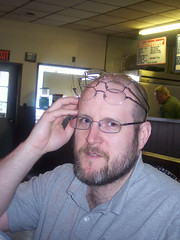Voter Fraud Just Ain't What She Used To Be
I’m surprised this isn’t getting more press, but the Government Accountability Office has issued this report which details wide spread voting irregularities surrounding the Diebold voting machines. The GAO is generally known as a thorough, impartial watchdog within the government, so when their report echoes a lot of what has been widely dismissed as “conspiracy theories”, we should all sit up and take notice.
The report is the result of a request by Congressman John Conyers to investigate the voting machines after the House Judiciary Committee received more than 27,000 complaints following the 2004 elections. As I’ve mentioned before, Warren O’Dell, CEO of Diebold, pledged before the election to do whatever was necessary to deliver Ohio to George Bush.
Borrowing a well written summary of some of the findings (originally written by Bob Fitrakis and Harvey Wasserman in October of this year), the report found:
1. Some electronic voting machines "did not encrypt cast ballots or system audit logs, and it was possible to alter both without being detected." In other words, the GAO now confirms that electronic voting machines provided an open door to flip an entire vote count. More than 800,000 votes were cast in Ohio on electronic voting machines, some seven times Bush's official margin of victory.
2. "It was possible to alter the files that define how a ballot looks and works so that the votes for one candidate could be recorded for a different candidate." Numerous sworn statements and affidavits assert that this did happen in Ohio 2004.
3. "Vendors installed uncertified versions of voting system software at the local level." 3. Falsifying election results without leaving any evidence of such an action by using altered memory cards can easily be done, according to the GAO.
4. The GAO also confirms that access to the voting network was easily compromised because not all digital recording electronic voting systems (DREs) had supervisory functions password-protected, so access to one machine provided access to the whole network. This critical finding confirms that rigging the 2004 vote did not require a "widespread conspiracy" but rather the cooperation of a very small number of operatives with the power to tap into the networked machines and thus change large numbers of votes at will. With 800,000 votes cast on electronic machines in Ohio, flipping the number needed to give Bush 118,775 could be easily done by just one programmer.
5. Access to the voting network was also compromised by repeated use of the same user IDs combined with easily guessed passwords. So even relatively amateur hackers could have gained access to and altered the Ohio vote tallies.
6. The locks protecting access to the system were easily picked and keys were simple to copy, meaning, again, getting into the system was an easy matter.
7. One DRE model was shown to have been networked in such a rudimentary fashion that a power failure on one machine would cause the entire network to fail, re-emphasizing the fragility of the system on which the Presidency of the United States was decided.
8. GAO identified further problems with the security protocols and background screening practices for vendor personnel, confirming still more easy access to the system.
Keep in mind, this is on top of the first ever case of exit polling being more than the statistical margin of error off from the actual results. (Interestingly, the second ever case came this year, also in OH, on the ballot question of whether the use of Diebold electronic voting machines should be investigated. How odd that a poll ON Diebold machines, that has a huge potential impact on future Diebold profits, would come in in Diebold's favor when polls showed a 2/3s majority leaning the other way.)
Election officials in at least two counties (Mahoning and Franklin) have admitted that they had at least 18 machines which, when a user tried to vote for John Kerry, would highlight George Bush’s name instead. Voters unfamiliar with the new machines might not have noticed and registered a vote they didn’t mean to register. Totals in both counties for Kerry were suspiciously low.
One voting machine in Mahoning County recorded a negative count of Kerry votes. The problem was reportedly fixed, but should we really have a voting system that allows for the possibility of returning NEGATIVE votes for a candidate?
One polling location recorded nearly 4000 votes for Bush when the location records show only 638 people voted there.
In Miami County, after the county’s central tabulator machine had registered a 100% tally of the vote, the count suddenly jumped by 19,000.
In New Mexico, John Kerry lost every single precinct where touch-screen voting machines were used, in numbers that didn’t match traditional party affiliation or ethnicity totals for the rest of the state.
And keep in mind the stories on election night of polling places still open and still having lines several hours long at 2 in the morning. These districts with too few voting machines (and fewer than they traditionally had had) were all in urban and college areas, traditionally Democratic supporters.
Even forgetting for the moment that every case of irregularity favored Bush over Kerry (statistically unlikely), these sorts of wide-scale problems in the election system should have us all screaming for oversight. If the 2004 election had taken place in another country, we would be decrying the illegitimacy of the result.
Liam.
(Although I have seen virtually all of the reports here listed in other places, I have borrowed heavily from a concise recap of them by Lyn Davis Lear.)



0 Comments:
Post a Comment
<< Home